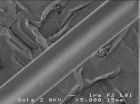(Press-News.org) New Haven, Conn. — New research led by Yale University scientists suggests that a rocky planet twice Earth's size orbiting a nearby star is a diamond planet.
"This is our first glimpse of a rocky world with a fundamentally different chemistry from Earth," said lead researcher Nikku Madhusudhan, a Yale postdoctoral researcher in physics and astronomy. "The surface of this planet is likely covered in graphite and diamond rather than water and granite."
The paper reporting the findings has been accepted for publication in the journal Astrophysical Journal Letters.
The planet — called 55 Cancri e — has a radius twice Earth's, and a mass eight times greater, making it a "super-Earth." It is one of five planets orbiting a sun-like star, 55 Cancri, that is located 40 light years from Earth yet visible to the naked eye in the constellation of Cancer.
The planet orbits at hyper speed — its year lasts just 18 hours, in contrast to Earth's 365 days. It is also blazingly hot, with a temperature of about 3,900 degrees Fahrenheit, researchers said, a far cry from a habitable world.
The planet was first observed transiting its star last year, allowing astronomers to measure its radius for the first time. This new information, combined with the most recent estimate of its mass, allowed Madhusudhan and colleagues to infer its chemical composition using models of its interior and computing all possible combinations of elements and compounds that would yield those specific characteristics.
Astronomers had previously reported that the host star has more carbon than oxygen, and Madhusudhan and colleagues confirmed that substantial amounts of carbon and silicon carbide, and a negligible amount of water ice, were available during the planet's formation.
Astronomers also thought 55 Cancri e contained a substantial amount of super-heated water, based on the assumption that its chemical makeup was similar to Earth's, Madhusudhan said. But the new research suggests the planet has no water at all, and appears to be composed primarily of carbon (as graphite and diamond), iron, silicon carbide, and, possibly, some silicates. The study estimates that at least a third of the planet's mass — the equivalent of about three Earth masses — could be diamond.
"By contrast, Earth's interior is rich in oxygen, but extremely poor in carbon — less than a part in thousand by mass," says co-author and Yale geophysicist Kanani Lee.
The identification of a carbon-rich super-Earth means that distant rocky planets can no longer be assumed to have chemical constituents, interiors, atmospheres, or biologies similar to those of Earth, Madhusudhan said. The discovery also opens new avenues for the study of geochemistry and geophysical processes in Earth-sized alien planets. A carbon-rich composition could influence the planet's thermal evolution and plate tectonics, for example, with implications for volcanism, seismic activity, and mountain formation.
"Stars are simple — given a star's mass and age, you know its basic structure and history," said David Spergel, professor of astronomy and chair of astrophysical sciences at Princeton University, who is not a co-author of the study. "Planets are much more complex. This 'diamond-rich super-Earth' is likely just one example of the rich sets of discoveries that await us as we begin to explore planets around nearby stars."
In 2011, Madhusudhan led the first discovery of a carbon-rich atmosphere in a distant gas giant planet, opening the possibility of long-theorized carbon-rich rocky planets (or "diamond planets"). The new research represents the first time that astronomers have identified a likely diamond planet around a sun-like star and specified its chemical make-up. Follow-up observations of the planet's atmosphere and additional estimates of the stellar composition would strengthen the findings about the planet's chemical composition.
### The authors of the paper are Madhusudhan, Lee, and Olivier Mousis, a planetary scientist at the Institut de Recherche en Astrophysique et Planetologie in Toulose, France.
The paper is titled "A Possible Carbon-rich Interior in Super-Earth 55 Cancri e."
The research was supported by the Yale Center for Astronomy and Astrophysics (YCAA) in the Yale Department of Physics through Madhusudhan's YCAA postdoctoral prize fellowship.
Illustration available.
Nearby super-Earth likely a diamond planet
2012-10-11
ELSE PRESS RELEASES FROM THIS DATE:
A new cave-dwelling reef coral discovered in the Indo-Pacific
2012-10-11
Coral specialist Dr. Bert W. Hoeksema of Naturalis Biodiversity Center in Leiden, The Netherlands, recently published the description of a new coral species that lives on the ceilings of caves in Indo-Pacific coral reefs. It differs from its closest relatives by its small polyp size and by the absence of symbiotic algae, so-called zooxanthellae. Its distribution range overlaps with the Coral Triangle, an area that is famous for its high marine species richness. Marine zoologists of Naturalis visit this area frequently to explore its marine biodiversity.
Reef corals in ...
How food marketers can help consumers eat better while improving their bottom line
2012-10-11
Food marketers are masters at getting people to crave and consume the foods that they promote. In this study authors Dr. Brian Wansink, co-director of the Cornell University Center for Behavioral Economics in Child Nutrition and Professor of Marketing and Dr. Pierre Chandon, professor of Marketing at the leading French graduate school of business, INSEAD challenge popular assumptions that link food marketing and obesity. Their findings presented last weekend at the Association for Consumer Research Conference in Vancouver, Canada point to ways in which smart food marketers ...
Research gives new insight into celiac disease
2012-10-11
For the first time, scientists have visualised an interaction between gluten and T-cells of the immune system, providing insight into how coeliac disease, which affects approximately 1 in 133 people, is triggered.
Published today in Immunity, the discovery was led by Dr Hugh Reid and Professor Jamie Rossjohn of Monash University, Professor Frits Koning of the University of Leiden and Dr Bob Anderson of biotechnology company ImmusanT Inc, based in the US.
An increasingly diagnosed chronic inflammatory disorder, coeliac disease affects the digestive process of the small ...
All healthcare professionals need training to deal with the sexual needs of patients
2012-10-11
Providing healthcare staff with a one-day training course on dealing with the sexual needs of people with an acquired physical disability gave them greater understanding of the issues patients faced and enabled them to address intimate questions more comfortably and proactively.
The findings were so encouraging that the authors of the study, published in the November issue of the Journal of Advanced Nursing, are calling for all healthcare practitioners to receive sexuality training, regardless of their role or the area of healthcare they work in.
Researchers surveyed ...
Queen's develops new environmentally friendly MOF production method
2012-10-11
Chemists at Queen's University Belfast have devised a novel, environmentally friendly technique, which allows the rapid production of Metal-Organic Frameworks porous materials (MOFs).
These revolutionary nanomaterials have the potential to transform hazardous gas storage, natural gas vehicles and drug delivery and have the highest surface-area of any known substance.
A sugar-lump sized piece of MOF material can have the same surface area as a football pitch.
Until now MOF manufacturing techniques have been limited as they are costly, slow and require large quantities ...
Research findings in solar cells will have an impact on solar panel industry
2012-10-11
University of Luxembourg's Laboratory for Photovoltaics has established a method to observe and prevent solar cell degradation before solar cell production is finished, which has implications for the solar cell manufacturing industry since chemical damage to solar cells can occur quickly.
Solar panels are capable of converting light energy from the sun into electrical energy because they contain solar cells – the "power generators" responsible for the energy in solar panels. Thin film solar cells have a coating that is responsible for absorbing the sun's energy, but ...
DNA confirms genetically distinct lion population for Ethiopia
2012-10-11
A team of international researchers has provided the first comprehensive DNA evidence that the Addis Ababa lion in Ethiopia is genetically unique and is urging immediate conservation action to preserve this vulnerable lion population.
While it has long been noted that some lions in Ethiopia have a large, dark mane, extending from the head, neck and chest to the belly, as well as being smaller and more compact than other lions, it was not known until now if these lions represent a genetically distinct population.
The team of researchers, led by the University of York, ...
A gene implicated in schizophrenia risk is also associated with risk for cannabis dependence
2012-10-11
Philadelphia, PA, October 11, 2012 – A paper by Shizhong Han and colleagues in the current issue of Biological Psychiatry implicates a new gene in the risk for cannabis dependence. This gene, NRG1, codes for the ErbB4 receptor, a protein implicated in synaptic development and function.
The researchers set out to investigate susceptibility genes for cannabis dependence, as research has already shown that it has a strong genetic component.
To do this, they employed a multi-stage design using genetic data from African American and European American families. In the first ...
Researchers create 'nanoflowers' for energy storage, solar cells
2012-10-11
Researchers from North Carolina State University have created flower-like structures out of germanium sulfide (GeS) – a semiconductor material – that have extremely thin petals with an enormous surface area. The GeS flower holds promise for next-generation energy storage devices and solar cells.
"Creating these GeS nanoflowers is exciting because it gives us a huge surface area in a small amount of space," says Dr. Linyou Cao, an assistant professor of materials science and engineering at NC State and co-author of a paper on the research. "This could significantly increase ...
Eco-friendly optics: Spider silk's talents harnessed for use in biosensors, lasers, microchips
2012-10-11
WASHINGTON, Oct. 11—Spiders use their silk to catch lunch. Now physicists are using it to catch light. New research shows that natural silk could be an eco-friendly alternative to more traditional ways of manipulating light, such as through glass or plastic fiber optic cables. Two teams independently exploring possible applications for the material's photonic talents will present their latest breakthroughs at the Optical Society's (OSA) Annual Meeting, Frontiers in Optics (FiO) 2012, to be held next week in Rochester, N.Y.
Biomedical engineer Fiorenzo Omenetto of Tufts ...



